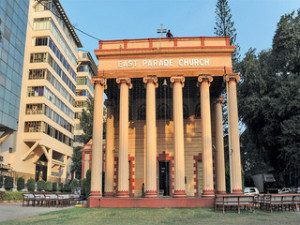One of the oldest churches in Bangalore, the East Parade Church, was built by Wesleyan Methodist missionaries for British soldiers stationed in Bangalore Cantonment. In England, the Wesleyan Methodist Church was formed as a breakaway sect from the Church of England.
The present church building was raised in 1865, with an inscription dated October 6, 1863, marking the laying of the foundation stone. The church was the earliest church built by the Wesleyans in Mysore district.
The Wesleyan Tamil Mission in the Bangalore Cantonment was established in 1821.Elijah Hoole of the Wesleyan Mission started a small school measuring 30 feet in length and 13 feet in breadth. Tamil services were started in the small school. However, in 1822, the Wesleyan Mission was suspended and the missionaries were transferred. In 1826, the mission resumed again but this time a stable in the Mission compound had to be used as a church.
The founder of the church in its present form was a gentleman called Thomas Hodson. A Wesleyan Missionary who served in India, Hodson was an extraordinary person. He arrived in India in 1829 when he was 25. He had spent three years in Calcutta learning Bengali and he was posted suddenly to Bangalore. The church was apparently dissatisfied by his performance in Calcutta because they decided that ‘results had not come up to their expectations’ (read numbers of conversions were inadequate). Before moving to Bangalore, Hodson wrote a long letter to the church committee mentioning that he had spent three years in learning Bengali and now he had to start again and learn Kannada. Hodson also suggested that preaching was not the only job of the Missionaries; teaching and education were just as important.
He came to Bangalore in 1833 and was stationed in Bangalore for almost three years. He was apparently a linguist of repute, being fluent in Bengali, Tamil and Kannada. A renowned Kannada scholar, he wrote a book on ‘An Elementary Grammar of the Kannada, or Canarese Language’ in 1864.
Hodson appears to have been a bit unhappy in Bangalore because he found that his time and efforts were taken away in preaching to the British and European officers, and he could not concentrate on the local population. He returned to England in 1843 due to ill health and came back to India in 1853 as Chairman and Superintendent of the Wesleyan Canarese Mission in the Mysore District. He left India in March 1878 and died in England in 1882.
In his description of Bangalore, Hodson describes two portions of the city. The Cantonment was where the soldiers lived and Tamil was the primary language. In the native town or petah, Kannada was the predominant language. Not surprisingly, Hodson appears to have concentrated his efforts on the Tamil speaking population rather that the people in the petahs. In 1834, Hodson purchased about 20 acres of land, just outside the Bangalore Petah which was where the United Mission School and Unity Buildings stand today. The first building to be constructed was the Wesleyan Mission Chapel, the predecessor of the present East Parade Church. The Wesleyan Mission Chapel was built in front of the Wesleyan Mission House, and could accommodate nearly 300 people. Located at the heart of the Cantonment, it was raised for the Tamil and the English congregations. The cost of raising the chapel was met by subscription by local Europeans. It was also reported that a ‘native who have received many honours from Lord William Bentinck’ contributed £100 towards raising the chapel.

The location of the church was striking. In front of the chapel was a wide esplanade, with trees lined up as an avenue, about a mile long. The esplanade was the erstwhile South Parade Road, now Mahatma Gandhi Road. The road to the right of the chapel was the present Dickenson Road which led to the Madras Army barracks. There was a large parade ground which covered the entire area from Cubbon Park to the present day Dickenson Road. The East Parade Church was constructed to the east of the parade ground and so perhaps there was no controversy in naming the church.
The annual report of the Wesleyan Mission of 1903 describes the East Parade Church as “…this lofty, roomy building is capable of accommodating 700 people. It is looked upon as the Cathedral of Methodism in the Province. The Church building has a number of unique features. The massive Corinthian columns, all eight in number, stand as sentinels at the entrance of the Church. These columns lend the whole structure its character. Another welcome feature of the building is that unlike other large churches in Bangalore it has no columns or pillars inside the church obstructing the view of the altar.”
Today, the East parade Church continues to serve two pastorates. These are the East parade Tamil and the East Parade Malayalam pastorates of the Karnataka Central Diocese. Thomas Hodson would probably be proud of the fact that the Church which was built primarily for the Tamil speaking population of the cantonment continues to serve the same function today.
source: http://www.bangaloremirror.indiatimes.com / Bangalore Mirror / Home> Bangalore> Others / Bangalore Mirror Bureau / by Siddharth Moorchung & Nikhil Moorchung / November 26th, 2017
